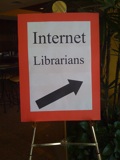I attended my first Internet Librarian conference this past week in beautiful Monterey, California. While my blog posts were infrequent, I soaked up a lot of good information from the presenters.
Wednesday morning’s session with a panel of three ‘born digital’ students was fascinating. Why I found it easier to grok this generation’s approach to technology from hearing it from their mouths, rather than reading Pew Internet reports or the work of danah boyd, I’m not sure. I was pleased to hear the members of this panel state how they understood the differences between ‘any old online resource’ [my phrasing] and the ‘good stuff’ [again, my words] libraries provide. I was entertained and a bit amazed at what I understood to be their attitude about technological innovation: that the speed of evolution in how we communicate and interact with the world around us is normal and unending. It makes me feel older than my years to hear eloquent and thoughtful high school students hold forth on the normalcy of technologies that I find, frankly, amazingly innovative and cool. I was struck by one of the participants’ statements that “twitter is dead”; amended by the youth librarian who helped convene the panel, who added “twitter was never alive.” The fact that this quote was repeated many times in the following minutes and hours on Twitter struck me as entertainingly ironic
Mobile devices and mobile computing were a focus of the conference as well. It seems that there is tremendous energy in libraries toward making services and functions available to the handheld devices. In not too many years, mobile devices will be the de facto standard of internet access, the one everyone has — not a computer. (This will be especially true in the developing world, which will bypass landline networking much as large swaths of the world have bypassed landline telephony.) An important point to remember is that the world does not use the iPhone, as much of a phenomenon it has been in some places. Even if the world is using mobile devices, they may not be using full graphic interfaces on those devices. Does this presage the reappearance of more gopher-like interfaces, ones that are much simpler to navigate on small-screen devices?
The Web Presence & Experience track was filled with excellent examples and advice on web design. Presentations covered a range of topics. Refreshingly, it seemed that everyone assumed that usability would be taking place — it is simply part of the process, not a super extra-special tool that only some people use. Innovation centered on services and enabling functionality, and much less on user testing and validating of designs. This is an excellent step.
Another interesting thing that I noticed is that almost nobody mentioned “RSS” as a tool or technology that needed to be explained. As I noted in my post about the lack of RSS support in Google Chrome last month, RSS is becoming invisible plumbing, something that just happens and is assumed. It appears less an active tool, and more a passive way to exchange information. Twitter, on the other hand, is alive and well. At least, among the Internet Librarians in attendance. As I publish this, there have been about 500 tweets with the #il2009 hashtag, from (in my estimate) 1,000 conference attendees.
And finally, a sign of the times…. In the lobby of the Monterey Marriott was the following sign, which made me wonder: Is there any other kind?
Skip to content

